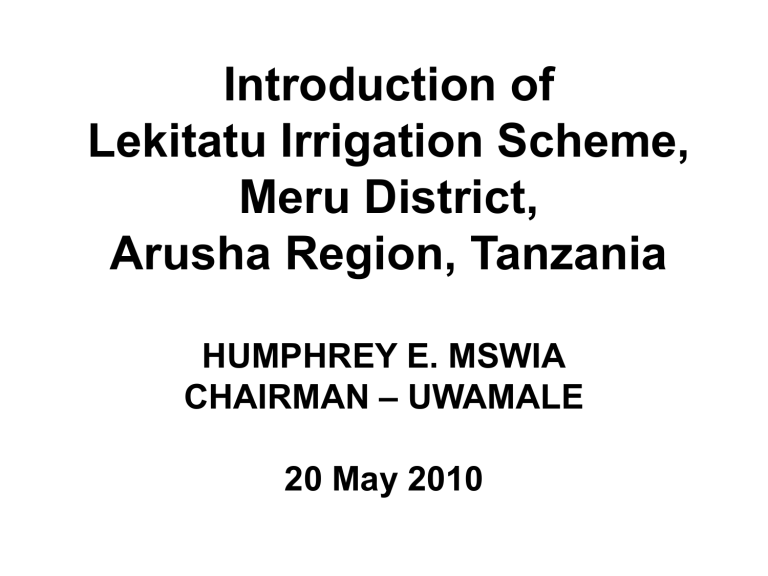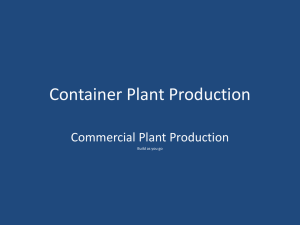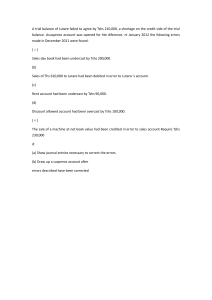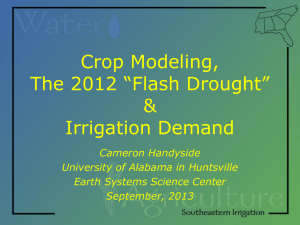Introduction of Lekitatu Irrigation Scheme Arusha

Introduction of
Lekitatu Irrigation Scheme,
Meru District,
Arusha Region, Tanzania
HUMPHREY E. MSWIA
CHAIRMAN – UWAMALE
20 May 2010
Background (1/2)
1961: Manyata Lekitatu village started
1975: Divided into 2 villages (Manyata and
Lekitatu)
Main activities before: Livestock keeping and traditional irrigation (in small areas)
2001: Construction of irrigation facilities completed through River Basin Management and Small-holder Irrigation Improvement
Project (RBMSIIP) supported by World Bank
Background (2/2)
• Total area of Lekitatu village: 836 ha
• Total area under irrigation: About 600 ha
Paddy: 400 ha
Upland: 200 ha (Beans: 100 ha, Maize: 72 ha,
Vegetables: 28 ha)
• Water sources: Ngarasero spring, Nurangimam spring and Tengeru river
• Farming households: 596 (Population: 2,950)
• Main activities at present: Crop production, livestock production, fish farming, petty businesses, etc.
Farmers Training (1/2)
1997: First training on improved irrigated rice cultivation at KATC (15 farmers participated)
1998: Training on irrigation and scheme management at KATC (20 farmers participated)
Changing Lekitatu village with:
• Expansion of irrigation areas through rehabilitation of irrigation facilities
• Adoption of improved rice cultivtion technologies through training
Farmers Training (2/2)
Before training
• Paddy yield: 6-8 bags per acre (1.2-1.6t/ha)
• One season per year
• Planting late maturing varieties (Supa India)
After training
• Paddy yield: 25-30 bags per acre (5.0-6.0 t/ha)
• Two seasons per year
• Planging early maturing varieties (Wahiwahi, Saro 5)
With making efforts of establishing 2 cropping seasons, operation and maintenance of irrigation facilities, agro-mechanization, and rice marketing
Farmers Organization (1/3)
1997: Formation of farmers organization with 15 members
Objectives
• Improving irrigation farming
• Improving the livelihood of farmers
• Uniting farmers and collecting water fees
• Enhancing access of farming inputs to members
• Conserving water resources
• Providing credits to members
Farmers Organization (2/3)
• Structure: Board (9 members), Chaiperson, Vice
Chaiperson, Secretary, Treasurer
• Six commitees: (1) Planning and finance; (2)
Operation; (3) Maintanance and rehabilitation;
(4) Supervision; (5) Education; and (6) Marketing
• Membership fees:
- Membership entrance fee: Tshs.1,000/=
- Share: Tshs.5,000/= (Maximum: 10 shares)
- Annual fee: Member (Tshs.3,000/= per acre);
Non member (Tshs.5000/= per acre )
- Water fee: Tshs.15,000/acre for outsiders
Farmers Organization (3/3)
Achievements
• Self employment
• Increase paddy yield and income
• Organized market (price)
• Improve food security and livelihood
• Increase membership (from 15 to 175)
Became a model scheme
(training other irrigation schemes)
Challenges
• High cost of farm implements
• High cost of farm inputs
• Poor accessibility during rain season
• Lack of common warehouse for storage
Management of a newly established Saving and Credit Cooperative Society (SACCOS)
Way forward
• Increase water fees
• Improve irrigation system
• Construction of storage warehouse
• Introduction of warehouse receipt system
• Increase number of farm implements
• Purchase of milling machine
• Shift from paddy to rice selling











